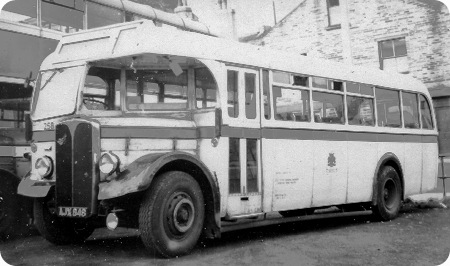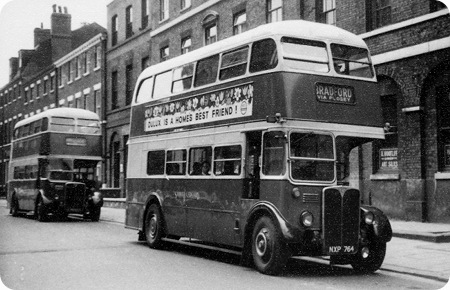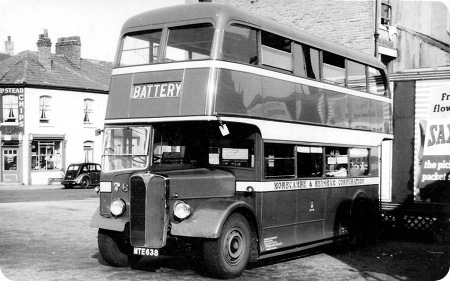
Photograph by ‘unknown’ if you took this photo please go to the copyright page.
Morecambe & Heysham Corporation
1951
AEC Regent III
Weymann H33/26R
This shot of a Morecambe & Heysham Regent III shows the older livery of green with three narrow cream bands, the newer livery which had an overall cream roof and a wider centre band can be seen here. This shot shows off very well the half drop windows which I should imagine were just the thing on a hot summers day whilst tootling up Morecambe promenade. Morecambe Corporation buses did not have route numbers just the destination and this bus is destined for ‘Battery which is more or less the centre point of the Morecambe promenade between Heysham harbour to the south and Morecambe golf club to the north.
When I say Battery ‘is’ I may mean ‘was’, when I researched this posting ‘Battery’ the place appears on Google maps along with the a little bed denoting ‘The Battery Hotel’ I am presuming that ‘The Battery ‘was an old military building. But on Google earth there is no mention of ‘Battery’ and all I can see is a car park I presume it is the map that is out of date. Does the place ‘Battery’ still exist or is it now just a car park if you know please leave a comment.
The Battery was a large public house situated very close to the Heysham Road Depot.
Buses running to the Battery would normally have started the journey at Happy Mount Park.
Terry Malloy
The Battery Hotel still exists. The Battery referred to on Morecambe buses was actually a bus park across the road from the pub it was also adjacent to the Morecambe depot. A recent visit to Morecambe revealed that the site is now a Drs surgery and retail pharmacy Stagecoach run the local services in the town. In the seventies Morecambe had a municipal depot as well as a Ribble one as did Lancaster. Part of Lancaster’s municipal depot is now converted into upmarket apartments called The Old Bus Depot!
Chris Hough
I believe that before Morecambe was developed as a holiday resort and expanded accordingly there was a firing range on the sands between Morecambe & Heysham with the Battery Hotel taking its name from an artillery battery which had been sited nearby. The bus park across the road took its name from the pub, which still gives its name to a timing point on the local bus network although a medical centre/pharmacy now stands on the site of the Battery Bus Park. The Battery is the boundary point between Morecambe & Heysham which were separate local authorities until 1928 when Heysham Urban District and Morecambe Borough Councils merged, the Morecambe & Heysham Corporation bus depot which was a couple of hundred yards south of The Battery was therefore in Heysham.
Ian Simpson
Morecambe were still running over 20 AEC Regent IIIs when they became part of the enlarged Lancaster fleet. Interestingly Morecambe were the last operator to run petrol engined double deckers they were certainly in use in the fifties. Also some of Morecambe’s pre-war double deckers had retractable canvass roofs for sunny weather a feature I would venture to suggest were unique unless anyone knows different .
Chris Hough
Actually the Battery was a field artillery station, when Morecambe was a training depot for the army in the late 1800s. The Battery hotel is named for this reason.
Andrew Wild
Yes Chris, the pre war Regents had roll back canvass roofs from the 1936 Park Royal batch up to the last pre war deliveries. These were panelled in during WW2. The relevant Park Royal bodies had an almost vertical rear dome to accommodate the roll up. I could never understand, as a youngster, why this was so different to the standard PR rear shape! There were some really unusual sounding destinations too, Bare, Happy Mount Park, Heysham Towers as well as "Battery" spring to mind.
John Whitaker
08/04/11 – 05:00
The canvas roofs were not unique to Morecambe double-deckers – in fact they were a short-lived fashion with coastal operators in the early/mid thirties, when they were of course very common on coaches. Southdown certainly had some Short-bodied TDs of this type, one of which I believe still survives.
David Jones
21/04/11 – 06:18
And not just coastal operators. Cheltenham & District had a couple of them for some inexplicable reason!
Chris Hebbron
21/04/11 – 06:31
Perhaps for the Cheltenham (Gold Cup) Festival?
David Oldfield
29/01/12 – 07:28
As youngster I travelled on these buses regularly in the 1950’s. They were always immaculate and looked very smart in their green livery. During the early 1980’s one restored bus, fleet no.69, LTF 254 ran on the promenade Happy Mount to the Battery service during the summer only. Does anyone know what happened to this bus? 20 JTE 546 and 35 KTF 594 were advertised for sale by Quantock Motor Services in Somerset back in Jan 2011 – where are they now?
James Welsh
29/01/12 – 16:34
Nothing really to do with buses but the mention of Bare reminds me that in the 1950s my grandparents and I always visited Morecambe for the Illuminations. We always came on a Yorkshire Woollen excursion and the coach always stopped for a refreshment stop at Ye Old Naked man at Settle. My Grandfather always cracked the same joke saying that the man lived at Bare. The premises are still at Settle but I don’t think that many coaches stop there these days.
Philip Carlton
17/04/12 – 07:03
At the risk of being accused of wandering ‘off topic’, there were (are they still there?) two establishments in the eastern part of Morecambe called the Bare Tennis Club and the Bare Women’s Institute, causing some merriment to visitors. I attended Morecambe Grammar School’s 6th form in the mid 1960’s, and several of my classmates hailed from the White Rose county. They called Morecambe "British West Bradford"!
Pete Davies
20/04/12 – 18:13
Re the diversion to the Bare district of Morecambe, I once read or heard that Morecambe Corp would run a fast duplicate service to that area, leaving the regular service for more local people. At the starting point, the conductress on the duplicate would apparently call out "Bare people only on this bus"! Whether that’s just someone’s made up story, or actually occurred, I know not.
Michael Hampton
21/04/12 – 08:20
…..but it’s worth the telling anyway. Couldn’t bear to miss it.
David Oldfield
21/04/12 – 08:21
Shades, Michael, of the "Loose Women’s Institute" in Maidstone !!
Chris Youhill
19/06/12 – 08:23
Morecambe’s petrol engined AEC Regents were still running until at least 1965 as open toppers. I worked on them then as a conductor during that summer after leaving school. As they were only 7′ 6" wide, collecting fares with standing passengers was a nightmare!
David Platt
19/06/12 – 09:16
The pre war Morecambe fleet was a classic collection of thoroughbred AEC Regents, with beautiful Park Royal or Weymann bodies, and they are engraved on my childhood memory. All were new with petrol engines, and the post 1936 Park Royal examples had sliding sun roofs, panelled in during WW2. a few survived as open toppers, as described by David above. There is a fleet list on this site to whet your appetite, which also covers Lancaster Corporation.
I just wish that I had taken photographs of these buses, as it was this fleet, during my early childhood, which cemented my interest in buses. I realised at an early age, that buses came in different, but subtle shapes, and that our home fleet in Bradford had some of identical pattern (Weymann).
If anyone knows of a photograph source for this pre war fleet, then I would love to know.
Another fascination was the haphazard, gap filling fleet numbering system, only just recently unwound in my mind thanks to the fleet list submitted by Dave Towers, for which , many thanks Memories!
John Whitaker
19/06/12 – 11:44
Well John, Sheffield were past masters at haphazard gap filling with the fleet numbers and with routes numbers. Possibly a bit biased, but I always preferred Sheffield to Manchester but I have to say the Manchester numbering system was always far better and more logical – 1000s and 3000s for Leyland, 2000s and 4000s for Daimler and blocks of route numbers for routes leaving the city down a particular common corridor.
David Oldfield
19/06/12 – 16:05
John If you can get hold of the Lancaster 75th anniversary brochure from 1978 you will find several shots of pre-war Morecambe buses including one overturned on the foreshore. The brochure can be obtained via Amazon. There is also a Super Prestige paperback album about Morecambe and Lancaster buses.
Chris Hough
20/06/12 – 08:08
Thanks Chris…I have both those publications, and also the "Morecambe Bay Buses" of c. 1978. The Super Prestige one is well worth having if you are a fan of either Lancaster and/or Morecambe. I just love the pre-war Lancaster "English Electric" flavour too! Bus shapes very similar to the Bradford Regen trolleys I was brought up with!
John Whitaker
21/06/12 – 06:57
Picking up David’s point, Manchester’s fleet numbering system was certainly a model of neatness, but its rationalisation of route numbers into corridor blocks was not without its critics. It has been suggested that it was far easier for passengers to remember the difference between 50, 64 and 161 than between the 41, 44 and 45 that replaced them.
Peter Williamson
10/10/12 – 09:34
Other than for a couple of brief breaks I lived in Morecambe from late 1958 up to 1982 and am therefore able to confirm/correct some of the above.
A bus coming along the promenade showing ‘Battery’ may indeed have come from Happy Mount Park, or it may have come from Central Pier. M & H were famous for sending spare crews out doing ‘promenades’, i.e. extras between the Battery and Central Pier – even when there was no earthly need for them! The turning arrangement at Central Pier was to back into a side street (Clarence Street I think it was called) – it would never be tolerated these days.
Buses also terminated at the Battery on the so-called ‘Circular’ service, i.e. Heysham Village – Battery – Promenade – Bare (Princes Crescent) – Torrisholme – Euston Road – Battery. After the arrival of the Leyland PD2s in 1960/62, they were the usual performers on the route.
I wouldn’t say that the Battery bus parking area was ‘adjacent’ to the depot – the depot being a full bus stop distance away. Don’t remember a firing range on the sands, but had there been one I probably wouldn’t have remembered it anyway.
I haven’t previously heard that the boundary between Morecambe and Heysham was at the Battery, or that the bus depot was in Heysham, but I’ve never been too sure where the boundary actually was so I’d better abdicate on this point.
I feel sure that the restored Regent III which ran on the promenade in the 1980s could only have been number 20 (JTE 546). Number 69 (KTF 254) was sold to the Mersey & Calder Bus Preservation Group in the late 1970s and is still, I believe, in preservation at present.
KTF 594 was fleet number 65 while with M & H.
I think that few people who have stopped for a break at Settle and parked in the car/coach park – even bus enthusiasts – will have realised that there is a bus depot located there. It certainly doesn’t stand out.
I think, Pete, that you have mentioned elsewhere that you attended Morecambe Grammar School in the 1960s. I did a full seven-year ‘stretch’ (1960-67) and I sincerely hope that your own experience of the place was significantly more positive than my own. This is perhaps a long shot, but did you happen to be a pal of one of the Mollitt twins? I wouldn’t be able to remember which one, but one thing I can remember is that they had forenames with the same initial letter – James and John I think.
Never known non-stop extras to Bare, I think that story’s apocryphal.
Morecambe’s last two pre-war Regents, 25 and 49, last ran, I think, in the summer of 1966, but they were diesel-engined by that time. I believe the conversion was quite late – possibly c1960 – by which time they were the only survivors. They were converted to open-top in time for the 1962 season, having been made surplus by the arrival of PD2As 90 and 91. When they were converted I believe the original gearboxes were retained, and as a diesel engine is much slower-revving than a petrol this made them hopelessly undergeared. I’ve heard that the drivers called them ‘two-gear’ buses – which would mean either second then top, or perhaps third then top.
David Call
24/06/13 – 11:40
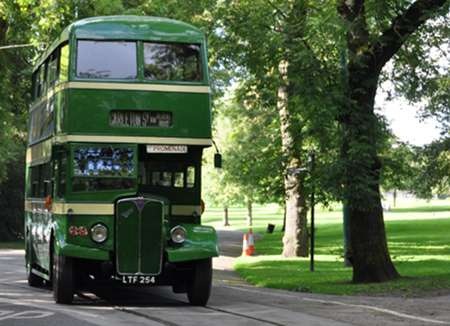
James Welsh (29/01/12) above asks whatever happened to LTF 254. Well it is preserved and was in service at the Ribble event in Morecambe this year – my picture was taken at Heaton Park on 4/9/2011
Ken Jones
24/03/14 – 13:46
Mention of petrol engined open-top Regents running until 1965 was a little off the mark. The last petrols (enclosed deckers) ran after the 1959 season, new Leylands replacing them the following winter. Two petrols had been converted to diesel after the war – these engines subsequently getting switched to ‘newer’ examples, and it was these which became open-topped from 1962 lasting till 1967 by when some Regent IIIs had been cut down. Open top 65 and enclosed 20 were sold by Quantock late in 2011 passing to Ukraine, 65 known to have been put into use at Sevastopol in red as "London Bus Cafe" (what else!).
Richard Allen
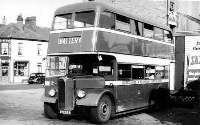 Vehicle reminder shot for this posting
Vehicle reminder shot for this posting
16/09/16 – 06:17
Last November John Hewitt and Daren Hunt bought MTE 635 from Ken Wade. Hopefully back on the road in 2 years time.
John Hewitt
